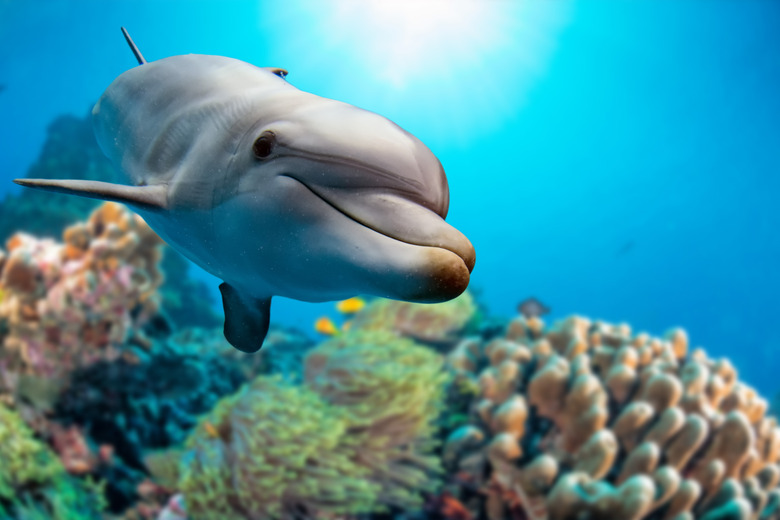How Do Dolphins Mate?
Dolphins are known for being highly intelligent and social creatures – these traits extend to their reproductive lives. Scientists believe dolphins communicate with one another and choose partners not only for protection and food gathering but also to find mates. Males show off and present gifts to attract the attention of females and successfully mate if the interest is returned.
TL;DR (Too Long; Didn't Read)
Dolphins are highly social intelligent mammals. Males go to great efforts to impress females in order to mate with them. Females generally give birth to one calf every three years.
Difference Between Males and Females
Males tend to be longer and heavier than females. The close presence of a calf usually indicates the dolphin is a female, but, like most mammals, the sex of a dolphin is best determined by seeing its genitals. Males have two slits that resemble an exclamation point with the genitals in the longer slit and the anus in the smaller, rounder one. Females have one continuous slit that contains both anal and genital openings as well as a series of slits that house the mammary glands. Though the age varies by their geographic location, females tend to reach sexual maturity at age 5 to 11, and males at age 7 to 14.
Male Dolphins Engage in Courtship
Male dolphins use physical displays to attract the attention of females. They can be seen posturing in exhibits such as the "rooster strut" where male bottlenose dolphins arch their head and bob up and down above the surface near a female. In a 10-year study in Australia, scientists witnessed physical posturing of males in which they appeared to flex and raise their head, tail or rostrum above the surface of the water. Still, others made a trumpeting noise with their blowhole. Researchers also witnessed male humpback dolphins woo females with gifts of large marine sponges before mating. Similar posturing behavior was also recorded in studies on Amazon river dolphins.
Male bottlenose dolphins travel in pairs or groups of up to four and work together to locate females who are ready to mate. These alliances may last for a season or for many years. Genetic tests indicate that the dolphins that fathered the most offspring tend to be members of large alliances.
Mating Season Lasts All Year
Unlike many other animals, dolphins have no true mating season. Males will court females and may mate at any time, although mating occurs more frequently after calving season. Although female dolphins can give birth to a calf every two years, in most cases, there is a three-year interval. Geographic locations seem to have influence as well. Scientists have noted peak times in certain areas during which more calves are born.
When interested in mating, dolphins engage in playful activity such as chasing each other, head-butting and scratching each other with their teeth, as well as lying on one side like a floating log. The actual act of mating is quick, generally lasting only a few seconds. Dolphins are not monogamous and usually mate with several other dolphins.
The Pod Serves as Family
Dolphins live in pods. The members are usually closely related and tend to be mostly of the same sex. In some cases, young calves stay with their mothers for life, and orphaned calves may be adopted by another dolphin in the pod.
Typical gestation is 11 ½ months and typically results in the birth of one calf. Births of twins are rare but have happened both in captivity and the wild. Pregnant females in the wild form maternity pods, and other dolphins may assist in the births. Females in the pod work together to raise the young. Male dolphins do not participate in rearing their young and, in some cases, have been known to be a danger to them.
Babies are born in the water, usually tail first, and the umbilical cord breaks during delivery. For the first few weeks, they are darker in color than the adults, which may serve as camouflage. They nurse underwater but close to the surface, for 5 to 10 seconds at a time, for a total of about 20 minutes a day. The nursing period lasts on average for about two years, though scientists have observed some calves that nursed up to four and half years.
Cite This Article
MLA
Yavorski, Kimberly. "How Do Dolphins Mate?" sciencing.com, https://www.sciencing.com/dolphins-mate-4574306/. 11 April 2018.
APA
Yavorski, Kimberly. (2018, April 11). How Do Dolphins Mate?. sciencing.com. Retrieved from https://www.sciencing.com/dolphins-mate-4574306/
Chicago
Yavorski, Kimberly. How Do Dolphins Mate? last modified March 24, 2022. https://www.sciencing.com/dolphins-mate-4574306/
